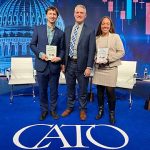
The year 2020 has already gone down in history as a crisis of unprecedented scale and consequences.
The COVID-19 pandemic has become a global stress test, which is nearing completion – many countries have already lifted all restrictions, and the world is gradually returning to what could be called normal life. However, it is obvious that viruses, like other pathogens, will stay with us for long, if not forever. Is it possible to build a new safe life in this environment?
A wave of news about a new infectious disease, monkeypox, ran through the headlines just a few weeks ago. The covid-weary international community took the message with a touch of panic: Spain promptly declared a health alert after only 23 cases were detected, and the WHO issued an official response around the same time. It seems that humanity is constantly on guard now, ready for any danger. This is now being called the new normal – but is a life with this pessimistic attitude really normal?
COVID-19, like other pathogens, will continue to pose a threat, and the obvious solution here is not to live in constant fear but to make every effort to create a truly safe environment, accessible to everyone. Vaccines used to be more or less successful, but the pandemic has shown that even they cannot be a panacea for all diseases. And while the importance of jabs is still undeniable, the forefront is now open for solutions that will protect us from pathogens and ensure minimal interference with our daily lives (think about the inconvenience of face masks).
As surprising as it may seem, such answers exist now, and many of them are already in use. They may be invisible in our daily routine, but after all, it is this invisibility that is one of their main functions. Their other features are accessibility and the “Do no harm” principle. Let’s take a look at how modern science helps to reduce the pathogenicity of the environment, and what invisible protectors surround us in everyday life.
The blue sign
Surfaces are some of the main breeding grounds for pathogens. It seems that treating them is not particularly difficult – there are plenty of sufficiently effective disinfectants. The problem, however, lies not so much in the ‘weapon’ as in its action: even the most effective product will not provide complete protection if a cleaner misses a spot. It would be great if we had a scale of cleaning completion, like in computer games – wiped everything, the scale is still 90%? Find a spot you haven’t noticed, and now the room is 100% clean!
Perhaps we will see it someday in augmented reality glasses, but right now we can use special-colored additives for cleaning products instead, like Highlight for Bleach by US-based R&D company Kinnos. The product literally stains unwashed and infected areas, and all that is required of the staff after cleaning is not to forget to look around: the dye disappears in a few minutes. “Many hospitals use cleaning scores to measure and retrain staff after the fact, or additive processes like UV light to avoid missed contamination,” says Kinnos CEO Jason Kang, “but now hospitals can instantly see what they’ve missed and simultaneously self-correct.”
The product is already being used in some hospitals, and a study has shown that it can improve performance, and therefore reduce the risk of infection, by 30%. For now, the bleach is only available to medical facilities, but perhaps it will appear on store shelves one day – which means Martha Stewart followers will get extra assurance of cleanliness in this world full of potentially dangerous little things.
Can touch this
Being able to clean everything down to the most hidden corners is great, but what about those surfaces for the cleanliness for which we are not responsible personally? How do you know if the table at the coffee shop where you’re about to have a cup of coffee is clean enough, or if that customer you ran into at the pharmacy’s front door didn’t sneeze straight on the counter? Life would be so much easier if such surfaces had a “Don’t Touch – Fresh Infection” labels!
The French technology Bioguard, developed by Bioguard & Co, a subsidiary of the French Oberthur Fiduciaire group, makes these imagined labels irrelevant. The antiviral and bactericidal coating shields from the risk of contamination on all kinds of surfaces, be it paper, cardboard, wood or glass, touchscreens, self-checkouts, and many others. This versatility may be questionable, but individual solutions are offered for each material, says Henri Rosset, Research Center Manager of Bioguard: “We adjust the dosages according to the surface that needs to be treated…We have developed coatings/varnishes that can be used on all types of materials.”
One of the perhaps best features of Bioguard is that it’s completely neutral to the human body and environment in general: once applied, it reduces the viral concentration by at least 100 times compared to untreated surfaces (as shown under ISO21702-2019 and ASTM E 1053-97 test conditions), but remains safe even for people with allergies, and does not affect the recyclability of objects. Don’t try to wash it away though, you won’t succeed: Bioguard remains effective over time as shown by lab tests on ageing. And next time, when you see a small white label ‘Bioguard’ on a table or anywhere else, be sure that it is safe for you and your health.
Freshly infected air
Alright, you’ve walked out of a thoroughly washed hospital, stopped by a store with its shelves treated with a special coating, paid with a self-checkout covered with the same coating, and got on the bus to drive home and enjoy the fresh air from the open window on the way. Can we relax now?
Not really. The very air you breathe and can’t live without may significantly shorten your life – thanks to what it carries. We knew the dangers of air pollution even before the pandemic, but living inside the pandemic taught us that even a light breeze can bring dangerous viruses and bacteria with it. It would seem impossible to shield against this if it weren’t for the innovative AirBubbl technology by London-based AirLabs, which not only filters the air but also cleanses it of pathogens.
Like the solutions above, AirBubbl was developed before COVID-19. Its original purpose was to clean the air of the big city pollutants, and it was used in cabs and subways. During the pandemic, the chemically modified nano-carbon filters, on which AirBubbl is based, were adjusted to additionally kill viruses and bacteria that would float around us, and the system’s performance was increased to ensure that the air is cleaned after onboarding quickly, and is kept clean throughout the voyage.
Just like the Bioguard coating, AirBubbl is anti-allergic and generally safe for humans: “When considering solutions, it is critical to choose a product that does not produce any harmful bi-products such as ozone and to think about the long-term protection it can provide,” explains Stuart Walker, head of product for AirLabs. This distinctive feature makes it possible to keep the windows in transport closed – now passengers do not have to choose between a chilly draft from the window and the prospect of sharing the breathing space with their sniffing and coughing fellow travelers.
Despite all the innovation and originality, neither this solution nor the ones we described above, can provide one hundred percent protection against all pathogens. In our text, we tried to simulate the most routine everyday situations which could pose a potential danger in the next pandemic. And if we manage to make them safe, we will be ready to face a new danger and live a normal life – in the full sense of this word.
Read more:
Viruses, bacteria: is building a new normal possible?





